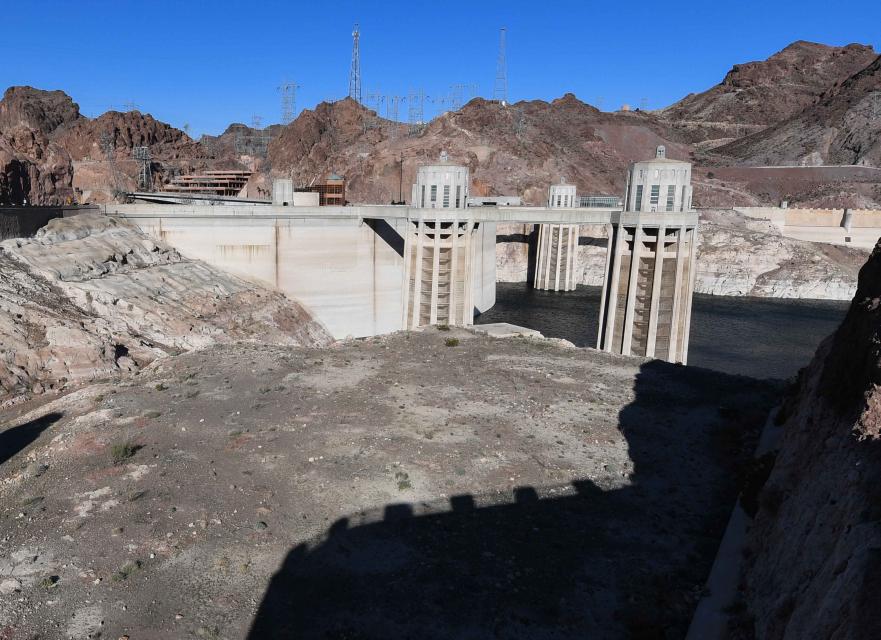As Colorado River Negotiations Near a Critical Deadline, a New Way of Looking at Risk is Revealing Hard Choices
Read our Western Water Article, Water Word of the Day and Five Don't-Miss Water Reads from Across the West
Dear Western Water readers:
 The seven Colorado River states are
racing to meet a Nov. 11 deadline from the Interior Department to
signal whether they believe they can reach agreement on a new
long-term operating strategy for the river’s dams and reservoirs.
But climate change and a now-quarter-century-long drought
have pushed relationships between the states to the breaking
point.
The seven Colorado River states are
racing to meet a Nov. 11 deadline from the Interior Department to
signal whether they believe they can reach agreement on a new
long-term operating strategy for the river’s dams and reservoirs.
But climate change and a now-quarter-century-long drought
have pushed relationships between the states to the breaking
point.
Over the past two decades, scientists, engineers and water managers have turned to long-term reconstructions of climate patterns and global climate models to better understand what the future might bring to the iconic Southwestern river. Despite that, they’ve been repeatedly blindsided after conditions on the river proved even worse than predicted.
Now, the federal Bureau of Reclamation is bringing a radically different style of thinking to the negotiating table. Decision Making Under Deep Uncertainty helps water managers test potential operating strategies against a far wider range of possible scenarios than has ever been considered before.
Read more about the concept and how it works in Western Water.
Water Around the West
Five don’t-miss articles from California and across the West:
Project Blue data center pushes ahead in Pima County promising new low-water cooling tech: Arizona Luminaria tracks data center developer Beale Infrastructure’s plans to move forward with Project Blue, this time promising a greener proposal that will use a new low-water air-cooling technology. The Arizona Department of Water Resources said the final user would have a few options, which could include groundwater at the site, access through a municipal water provider, or the use of long-term storage credits.
Beavers restored to tribal lands in California benefit ecosystems: John Cannon of Mongabay reports on the Tule River Tribe’s decision to bring beavers back to shore up their reservation’s water. The potential benefits of beavers include fire prevention, improved water quality and fishing. In 2023, the state began a beaver restoration program partnering with the Tule River Tribe, as well as the Mountain Maidu people in northern California, to move beavers to tribal lands.
The dwindling Colorado River can’t wait for states to cut water use, experts say: Another dry year could push already depleted Colorado River reservoirs to dangerously low levels, experts warn in a new analysis. The Los Angeles Times’ Ian James reports that the researchers are urging the Trump administration to impose urgent water cuts across the seven states – California, Arizona, Nevada, New Mexico, Colorado, Utah and Wyoming – that rely on the river.
Fresno, California, growers appeal to Supreme Court: The city of Fresno and more than a dozen irrigation districts and private landowners are asking the Supreme Court to review a long-running water rights case, which centers on the federal government’s decision to curtail water deliveries in 2014. E&E News by Politico’s Jennifer Yachnin reports that the plaintiffs seek $350 million to repay the fair market value of the lost water.
Adult zebra mussels found in Colorado River, which is now designated “infested”: Shannon Mullane of the Colorado Sun reports that Colorado state officials have confirmed that the fast-reproducing mussels now have a toehold in the river. The invasive mussels hurt food systems for other aquatic species and their buildup ruins water infrastructure.
Western Water Word of the Day
 In 2005, after five years of severe
drought in the Colorado River Basin, federal officials and
representatives of the seven basin states — California, Arizona,
Nevada, New Mexico, Colorado, Utah and Wyoming — began building a
framework to respond to drought conditions and coordinate the
operations of the basin’s two key reservoirs, Lake
Powell and Lake Mead. The effort resulted in the
Colorado River 2007 Interim Guidelines and eventually the Drought
Contingency Plans. Those plans expire next year, and negotiators
are now working to meet the deadline for a new agreement. But
progress has been slow as they wrestle with what water cuts will
be needed in dry years. Learn more about the Colorado
River 2007 Interim Guidelines and Drought Contingency
Plans in Aquapedia, our online water
encyclopedia.
In 2005, after five years of severe
drought in the Colorado River Basin, federal officials and
representatives of the seven basin states — California, Arizona,
Nevada, New Mexico, Colorado, Utah and Wyoming — began building a
framework to respond to drought conditions and coordinate the
operations of the basin’s two key reservoirs, Lake
Powell and Lake Mead. The effort resulted in the
Colorado River 2007 Interim Guidelines and eventually the Drought
Contingency Plans. Those plans expire next year, and negotiators
are now working to meet the deadline for a new agreement. But
progress has been slow as they wrestle with what water cuts will
be needed in dry years. Learn more about the Colorado
River 2007 Interim Guidelines and Drought Contingency
Plans in Aquapedia, our online water
encyclopedia.
At the Foundation
 The agenda for our
annual Water Summit
is now online, with the
first panel kicking off a discussion on Forecasting in Flux:
Decision-Making in a Changed Climate. The Water Summit, on
Wednesday, Oct. 1 in downtown Sacramento, will
feature California Natural Resources Secretary Wade Crowfoot and
former U.S. Reclamation Commissioner Brenda Burman as part of an
exciting line-up of water and policy experts. Get more
information and
your tickets here.
The agenda for our
annual Water Summit
is now online, with the
first panel kicking off a discussion on Forecasting in Flux:
Decision-Making in a Changed Climate. The Water Summit, on
Wednesday, Oct. 1 in downtown Sacramento, will
feature California Natural Resources Secretary Wade Crowfoot and
former U.S. Reclamation Commissioner Brenda Burman as part of an
exciting line-up of water and policy experts. Get more
information and
your tickets here.
Western Water Resource
 Learn about the history and
challenges facing the West’s most dramatic and
developed river in our Layperson’s Guide to the
Colorado River Basin. The guide introduces the
1,450-mile river that sustains 40 million people and millions of
acres of farmland across seven states and parts of northern
Mexico. The 28-page primer explains how the river’s water is
shared and managed as the Southwest transitions to a hotter and
drier climate. The guide covers the agricultural, tribal,
environmental and recreational interests tied to the Colorado as
it gushes from the Rocky Mountains, carves through the Grand
Canyon and trickles toward the Gulf of California. Order
your copy here.
Learn about the history and
challenges facing the West’s most dramatic and
developed river in our Layperson’s Guide to the
Colorado River Basin. The guide introduces the
1,450-mile river that sustains 40 million people and millions of
acres of farmland across seven states and parts of northern
Mexico. The 28-page primer explains how the river’s water is
shared and managed as the Southwest transitions to a hotter and
drier climate. The guide covers the agricultural, tribal,
environmental and recreational interests tied to the Colorado as
it gushes from the Rocky Mountains, carves through the Grand
Canyon and trickles toward the Gulf of California. Order
your copy here.








